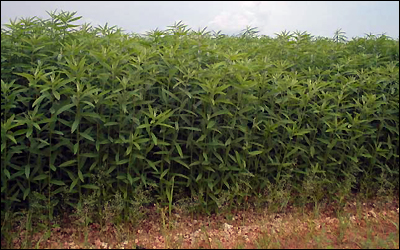Research
Development of a Best Management Practice for Sustainable Water Quality in the South Dade Everglades Agricultural Region
A collaborative (USDA-ARS SWRL/UF-TREC) research/demonstration project was designed to evaluate the extent to which residues of fertilizers and pesticides used to produce sweet corn affect groundwater and how the use of summer cover crops can reduce and minimize potential leaching and preserve the aquifer. Details on the research team and funding for this project can be obtained here.
Six experimental plots (47×29 m each) were studied during 4 years (1999-2003) on a 4 ha field at UF-TREC. Half of the plots were selected randomly as the BMP treatment plots. The BMP consisted of a summer cover crop planted after the winter sweet corn crop was harvested. Crop management followed growers' practices in the area. The crop was fertigated with a sprinkler set fed by a portable pump in a field well. The plots were instrumented with 34 shallow sampling and monitoring wells (4.6 m depth), three of them continuously recording water table depth, an automatic rain gauge, and 8 soil moisture (capacitance) probes to continuously record moisture changes at three soil depths (15, 25, and 35 cm). Three additional wells were installed in the perimeter of UF-TREC, 800 m away from the field and instrumented for continuous recording of water table elevation. A large drainage canal in the NE corner of the UF-TREC property was also instrumented for continuous stage recording to obtain a boundary condition for the shallow groundwater flow field.

Sunn hemp grown on the experimental plots at TREC.
Preliminary results show a significant soil moisture trend difference between cover and no cover plots. The cover crop plot soil retained more water after each rain event. The net effect of this trend is lower leaching rates on the cover crop plots. Concentrations of nutrient and pesticide residues on water samples collected from monitoring wells under cover crop and no cover crop plots showed consistently higher values in the no cover crop wells. Two water quality models (GLEAMS and WAVE) are being tested to predict potential changes in deep soil drainage caused by the BMP. Initial results showed that the BMP was effective in delaying and reducing deep drainage rates in the soil, thus increasing the opportunity for chemical degradation.
In addition several tracer tests are being conducted to asses the transport characteristics of the solutes, once transported through the vadose zone, in the Biscayne aquifer. Results from studies of this type will contribute to enhanced water quality and promote agricultural sustainability in the region.
The following presentation gives details about this on-going project (requires Adobe Reader to view .pdf documents; advance presentation using Page Down/Up keys; exit with Escape key):
- Development of a BMP for Sustainable Water Quality in the South Dade Everglades Agricultural Region [944KB]
This page was last updated on July 13, 2019.